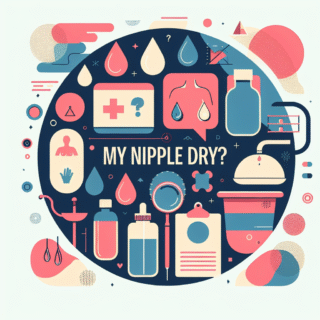
More Family/Primary Care Articles
Why Is My Nipple Dry?

Dryness of the areola or nipple can be uncomfortable and leave you wondering what’s behind the change. If your nipple dry skin feels tight, flaky, or irritated, it’s a common concern that can arise from many benign causes as well as a few that need medical attention. This article explains typical reasons for dryness, offers self-care strategies, and helps you decide when to see a clinician.
Nipple Dry and Itchy: Common Causes
When a nipple is dry and itchy, the most likely culprits are simple and treatable. Dry skin (xerosis) from low humidity, harsh soaps, or frequent washing can remove natural oils. Contact dermatitis from fragranced lotions, laundry detergents, or fabric softeners may cause redness, scaling, and itch. Eczema and atopic dermatitis can involve the nipple area and lead to chronic dryness that flares periodically.
Breastfeeding can also explain why are my nipple dry or sore. Frequent nursing, poor latch, and repeated cleaning can strip protective oils, causing cracks and flaking. For people who use breast pumps, friction and ill-fitting flanges may irritate the skin. In these cases, a simple barrier ointment or lanolin and adjustments to technique often help.
Skin conditions, infections, and hormonal factors
Fungal infections such as Candida can cause itchiness with dry, flaky skin and sometimes a burning sensation. Bacterial infections or mastitis more commonly present with pain, warmth, and systemic symptoms like fever. Hormonal changes during pregnancy, menstruation, or menopause can alter skin texture and oil production — you might wonder, why is my nipple so dry during certain times of the month? Fluctuating hormones can be the reason.
Less common but important causes include Paget’s disease of the breast, which can mimic eczema and produce persistent crusting or erosion of the nipple. Any persistent, unilateral changes, bleeding, or a lump should prompt evaluation. If you ask, what does it mean when your nipple is dry and it does not improve with basic care, seek medical attention to rule out more serious conditions.
When to suspect an allergic reaction or dermatitis
If the dryness is accompanied by sharp itching, blisters, or a clear pattern that matches contact with a product, consider contact dermatitis. Testing your routine—switching to a fragrance-free soap, avoiding topical medications, and wearing cotton next to skin—can reveal triggers. If symptoms improve when you stop a product, that confirms the diagnosis. For persistent problems, a dermatologist can perform patch testing to identify specific allergens.
Practical self-care and treatment tips
- Switch to gentle, fragrance-free cleansers and avoid alcohol-based products on the breast area.
- Moisturize with a fragrance-free emollient after bathing; for breastfeeding, use a nipple-safe ointment like purified lanolin between feeds.
- Protect cracked or irritated skin from further friction by wearing soft, breathable fabrics and using properly fitted bras.
- Limit hot showers and central heating exposure when possible, since both dry the skin.
- If you suspect infection (increasing pain, pus, fever), see your clinician for evaluation and possible topical or oral treatment.
If you’re thinking, “my nipple is dry but I don’t know why,” keeping a brief diary of products used, changes in weather, breastfeeding patterns, and new clothing can reveal patterns. For example, a switch in detergent or a new soap often shows a clear temporal link to symptoms.
For a general anatomical overview and more background, the Wikipedia article on the nipple offers concise context about structure and common conditions: nipple anatomy and conditions (external reference).
For ongoing reading on skin care and breast health updates, check our collection of recent articles and expert interviews in the magazine: Explore our latest editions on skin and breast health.
Takeaways
- Dry, flaky nipples are usually caused by irritation, dermatitis, or environmental factors and often improve with gentle care.
- Breastfeeding, friction, and hormonal changes are common contributors to nipple dryness and soreness.
- Persistent, one-sided changes, bleeding, or nonhealing lesions require medical evaluation to exclude serious causes.
- Simple measures—mild cleansers, emollients, protective clothing, and addressing triggers—can resolve most cases.
FAQ
Why is my nipple dry after breastfeeding?
Frequent nursing and cleaning can remove natural oils and cause friction-related breakdown of the skin. Improving latch, using a nipple barrier ointment between feeds, and ensuring time for skin to heal can help. If symptoms include severe pain, fever, or pus, see a clinician.
What should I do if my nipple is dry and doesn’t improve?
If basic care for two weeks—gentle cleansers, moisturizers, stopping suspected irritants—doesn’t help, consult your primary care provider or a dermatologist. They can check for infections, allergic dermatitis, or less common causes like Paget’s disease and recommend targeted treatment.
Other Articles You May Find of Interest...
- From Checkups to Emergencies: When to Visit a Family Clinic vs. a Walk-In Clinic
- Your Questions Answered: Benefits Castor Oil
- What’s Pulmonary Edema?
- Why Is My Nipple Dry?
- Treatment for Pulmonary Edema: Results, Ranges, and What They Mean
- Coconut Oil for Vagina: Symptoms, Causes, and Treatment
- How to Treat Pulmonary Edema














